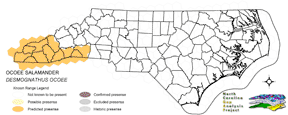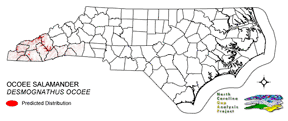
| Taxa: |
| Order: |
| Family: |
| Amphibia |
| Caudata |
| Plethodontidae |
| NatureServe Global Rank: |
| NatureServe State (NC) Rank: |
| G2G3 |
| S? |
| Federal Status: |
| NC State Status: |
| --- |
| --- |


| Land Unit |
| US Fish & Wildlife Service |
| US Forest Service |
| US National Park Service |
| US Department of Defense |
| NC State Parks |
| NC University System |
| NC Wildlife Res. Com. |
| NC Forest Service |
| NC Div. of Coastal Mgmt. |
| Local Governments |
| Non-Governmental Org. |
| Other Public Lands |
| Private Lands |
| GAP Status 1-2 |
| All Protected Lands |
| Statewide |
| Hectares |
| 0.00 |
| 51,309.90 |
| 39.15 |
| 32,856.39 |
| 305.82 |
| 0.00 |
| 1,180.17 |
| 267.57 |
| 0.00 |
| 0.00 |
| 194.13 |
| 0.00 |
| 64,065.24 |
| 42,570.27 |
| 86,086.98 |
| 150,218.37 |
| Acres |
| 0.00 |
| 126,789.50 |
| 96.74 |
| 81,189.89 |
| 755.70 |
| 0.00 |
| 2,916.26 |
| 984.10 |
| 0.00 |
| 0.00 |
| 479.71 |
| 0.00 |
| 158,308.62 |
| 105,516.32 |
| 213,048.44 |
| 371,520.52 |
| % of Dist. on |
| Prot. Lands |
| 0.0 % |
| 59.6 % |
| 0.0 % |
| 38.2 % |
| 0.4 % |
| 0.0 % |
| 1.4 % |
| 0.3 % |
| 0.0 % |
| 0.2 % |
| 0.2 % |
| 0.0 % |
| 0.0 % |
| 49.5 % |
| ----- |
| ----- |
| % of Dist. on |
| All Lands |
| 0.0 % |
| 34.2 % |
| < 0.1 % |
| 21.9 % |
| 0.2 % |
| 0.0 % |
| 0.8 % |
| 0.2 % |
| 0.0 % |
| 0.0 % |
| 0.1 % |
| 0.0 % |
| 42.6 % |
| 28.3 % |
| ----- |
| ----- |
|
This species is located in mountain ranges at the most southerly portion of the southern Appalachians in Tennessee, North Carolina and Georgia, with a disjunct population occurring into northern Alabama. In North Carolina, the salamander is found in the Unicoi, Cowee, Balsam, Great Smoky, Nantahala, Snowbird, Tusquitee, and Blue Ridge mountains
(Petranka 1998). Within its range, the salamander occurs at mid and high elevations, but lower elevational limits are not well defined. Lower elevation populations (those generally below 4500 ft) have been found in stream gorges of the Hiwasee, Ocoee, and Tugaloo Rivers, and are closely associated with moist stream and seepage borders (Petranka 1998). Populations above 4500 ft inhabit wet rockfaces, seepage areas and the forest floor, but are less restricted to the immediate vicinity of wet sites and streams. NATURE SERVE GLOBAL HABITAT COMMENTS: At lower elevations and in winter usually concentrates near seepage areas, springs, and small streams; may range into adjacent wooded areas in wet weather. More terrestrial at higher elevations, characteristic inhabitant of floor of spruce-fir forests. Often abundant on wet rock faces. Eggs are laid in wet rock crevices or under rocks, logs, or moss in seepage areas or near small streams. |
| Code | Name | Description | NC Natural Heritage Program Equivalent |
| 228 | Piedmont Dry-Mesic Oak and Hardwood Forests | Primarily oak dominated forests, white oak is often dominant, with co-dominants including . Also represented by sweetgum and tulip poplar dominated forests. | Dry Mesic Oak Hickory Forest, Basic Oak Hickory Forest, Dry Oak Hickory Forest |
| 517 | Hemlock Floodplain Forest | Alluvial forest with hemlock and/or white pine in mountains and western piedmont. Hydrology is generally temporarily to seasonally flooded. | Canada Hemlock Forest |
| 521 | Spruce/Fir Forest | High Elevation Frazer-Fir - Red Spruce, Red Spruce and Red-Spruce-Yellow Birch Forests. Tree densities included here include both woodland to forest density. Highly intermixed with Northern Hardwoods, Grassy Balds, and Shrub Balds. | Red Spruce--Fraser Fir Forest, Fraser Fir Forest |
| 522 | Northern Hardwoods | High Elevation forests including yellow birch, American beech, and yellow buckeye. Includes forests with Hemlock and Yellow Birch. | Northern Hardwoods Forest, Boulderfield Forest |
| 525 | Appalachian Oak Forest | A variety of oak forest types including Black, White, Scarlet Oaks in dry to mesic situations. Includes forests historically co-dominated by American Chestnut. | High Elevation Red Oak Forest, Montane White Oak Forest |
| 526 | Appalachian Cove Forest | Mixed Mesophytic forests of the mountains. Includes tuliptree, basswood, yellow buckeye and surgar maple. This class is mapped to include cove forests dominated or co-dominated by hemlock. | Rich Cove Forest, Acidic Cove Forest |
| 527 | Appalachian Hemlock | Upland hemlock forests of the moutains region. Vary from side slopes to steep slope positions. | Canada Hemlock Forest |
| 533 | Appalachian Swamp Forest | Evergreen and deciduous forests with saturated hydrologies. This class may contain a variety of trees species, including hemlock - red maple, pitch pine, and white pine forests. | Swamp Forest-Bog Complex, Southern Appalachian Bog, Southern Appalachian Fen |
| 534 | Appalachian Wet Shrubland/ Herbaceous | Saturated shrubs and herbaceous vegetation. Often mapped as an inclusion in Appalachian Swamp Forest. | Southern Appalachian Bog, Southern Appalachian Fen |
|
Hairston, N. G., Sr., and R. H. Wiley. 1993. No decline in salamander (Amphibia:Caudata) populations:a twenty-year study in the southern Aplachians. Brimleyana 18:59-64.
Petranka, J. W., M. E. Eldridge, and K. E. Haley. 1993. Effects of timber harvesting on southern Appalachian salamanders. Conservation Biology 7(2):363-370. Petranka, J. W. 1998. Salamanders of the United States and Canada. Washington DC: Smithsonian Inst. Press. Bruce, R. C. 1989. Life history of the salamander DESMOGNATHUS MONTICOLA, with a comparison of the larval periods of D. MONTICOLA and D. OCHROPHAEUS. Herpetologica 45:144-155. Huheey, J. E., and R. A. Brandon. 1973. Rock-face populations of the mountain salamander, Desmognathus ochrophaeus, in North Carolina. Ecological Monographs 43:59-77. |
For more information please contact them at:
NC-GAP Analysis Project
Dept. of Zoology, NCSU
Campus Box 7617
Raleigh, NC 27695-7617
(919) 513-2853
www.basic.ncsu.edu/ncgap